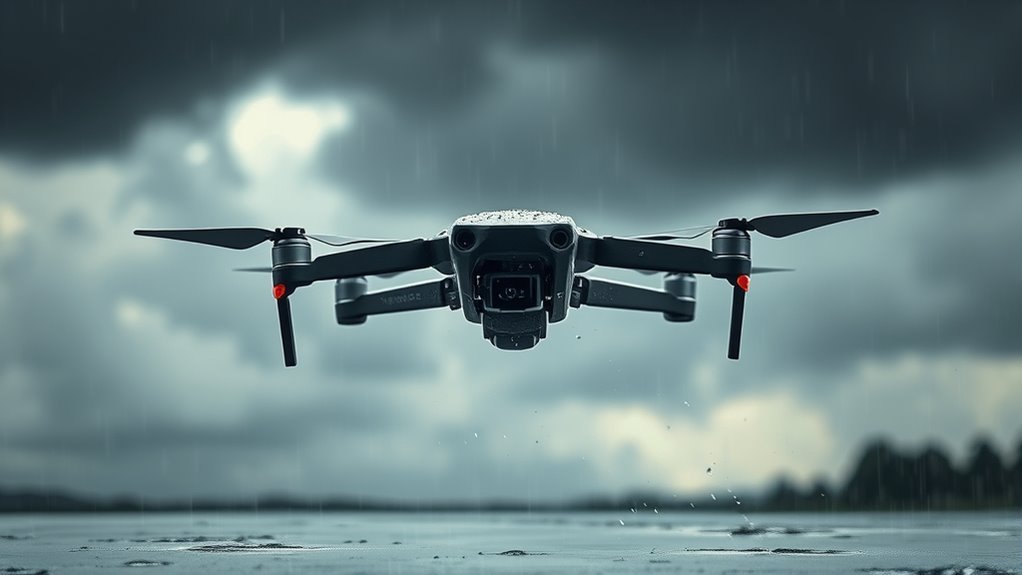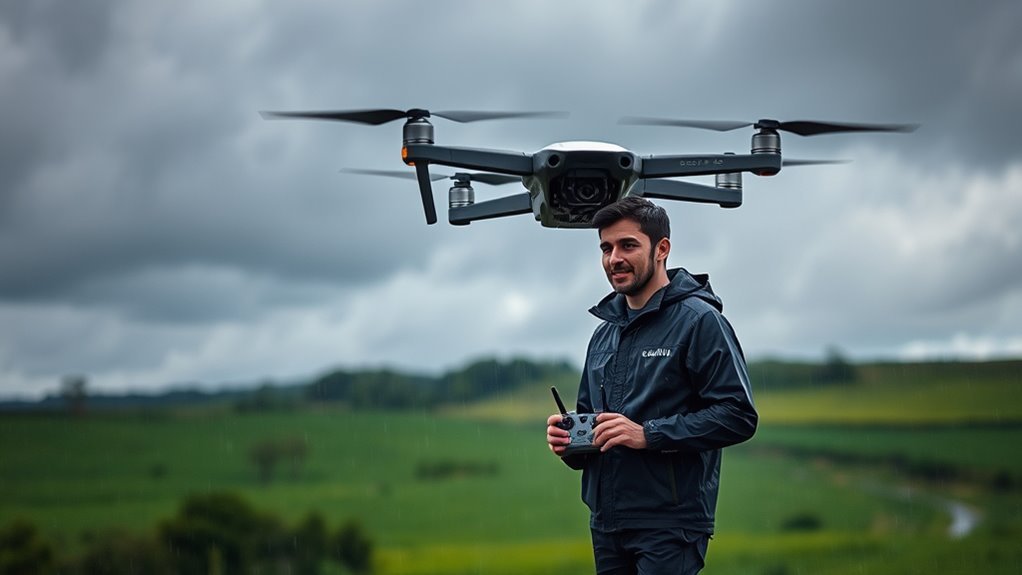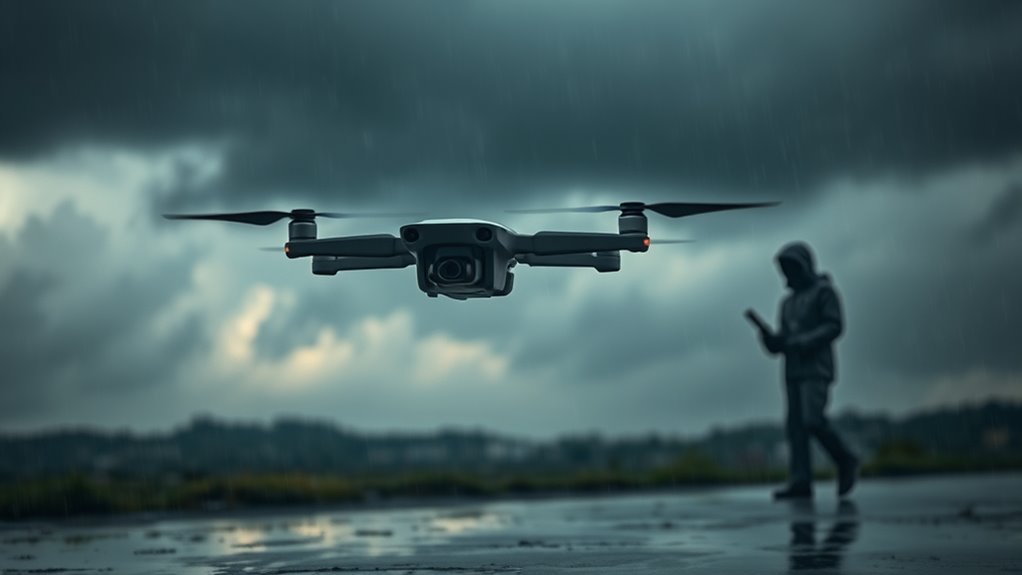To safely fly drones in rainy weather, assess the drone’s waterproof ratings, and prepare it with waterproofing techniques like silicone sealant. Check humidity levels and maintain visibility with weather radar. Use lens hoods to prevent water droplets on the camera and stabilize your flight to reduce vibrations. After flying, inspect for moisture ingress and guarantee components are dry before storage. Understanding these factors will help you make informed decisions for flying in challenging conditions.
Understanding Drone Weather Resistance

Although many drones are designed for various environmental conditions, understanding their weather resistance is essential for safe operation in rainy weather. The materials used in drone construction play a critical role in determining how well it can withstand moisture. For instance, drones made from waterproof composites or treated plastics can better resist rain damage. Additionally, incorporating moisture sensors can help monitor humidity levels and prevent electrical failures during flight. These sensors enable you to make informed decisions about whether it’s safe to fly. If your drone lacks adequate weather resistance, you risk compromising its functionality and longevity. Always evaluate your drone’s specifications and invest in additional protective measures if you plan to operate in challenging conditions. Furthermore, knowing the IP (Ingress Protection) ratings of your drone can provide valuable insight into its water resistance capabilities. Understanding the signal attenuation that occurs in wet conditions can also help you anticipate potential communication issues during flights.
Assessing the Risks of Flying in Rain

Before flying your drone in the rain, it’s vital to assess its water resistance levels and how they align with the current conditions. Low visibility can greatly impact flight safety and control, making it necessary to evaluate your surroundings. Always prioritize these factors to minimize risks and guarantee a safe flying experience. Additionally, understanding drone durability can help you make informed decisions about flying in adverse weather conditions.
Drone Water Resistance Levels
When considering flying your drone in rainy weather, understanding its water resistance level is essential. Different drones come with varying drone ratings that indicate their ability to withstand moisture. Look for models with waterproof features, which can enhance their longevity and performance in wet conditions. However, even drones with high water resistance aren’t invincible; excessive exposure can lead to malfunctions. Always check the manufacturer’s specifications to determine if your drone can handle light rain or if it’s meant for completely dry environments. If you’re unsure, it’s best to err on the side of caution and avoid flying in adverse weather. Knowing your drone’s limitations allows you to enjoy the freedom of flight while minimizing risk.
Visibility and Flight Safety
Flying a drone in rainy weather can greatly impair visibility, making it crucial to assess the associated risks. Rain introduces visibility challenges that can obscure your view of the drone, making navigation difficult. You might encounter flight hazards such as strong winds and reduced signal quality, which can lead to loss of control. Before flying, check the weather conditions and verify you can maintain visual line-of-sight. If visibility drops, it’s better to postpone your flight. Remember, even if your drone is water-resistant, poor visibility can lead to costly crashes or damage. Prioritize safety over freedom; the skies will still be there when the weather clears. Always weigh the risks against your desire for adventure.
Preparing Your Drone for Wet Conditions

Although many drones are designed to withstand minor moisture, preparing your drone for wet conditions is essential to secure peak performance and safety. Start by applying drone waterproofing techniques, such as using silicone sealant on exposed components and connections. Invest in weatherproof materials like protective cases or covers specifically designed to shield your drone from rain. Ascertain that all electronic parts are sealed properly to minimize the risk of water damage. Check the battery compartment for proper sealing, as water intrusion can lead to short circuits. Additionally, consider using propeller guards to prevent water from splashing onto critical components during flight. By taking these precautions, you’ll enhance your drone’s resilience and enjoy the freedom of flying even in less-than-ideal weather.
Techniques for Maintaining Control and Visibility
When flying in rainy conditions, you must conduct a thorough pre-flight weather assessment to gauge the severity of the rain and its impact on visibility. Utilizing anti-rain gear can help protect your drone’s components, while adjusting flight settings guarantees peak control. These techniques are essential for maintaining safe and effective operation in adverse weather.
Pre-Flight Weather Assessment
Before you take off in rainy conditions, it’s crucial to conduct a thorough pre-flight weather assessment to guarantee both control and visibility. Utilize weather radar to analyze current precipitation patterns, making sure your drone won’t encounter unexpected downpours. Pay attention to wind conditions and forecasted changes, as they can affect your drone’s stability.
| Assessment Factor | Recommended Action |
|---|---|
| Precipitation | Check weather radar for real-time updates |
| Wind Speed | Measure wind gusts; avoid flying in strong winds |
| Visibility | Verify visibility is sufficient for safe operation |
Use of Anti-Rain Gear
As you prepare to fly in rainy weather, consider employing anti-rain gear to enhance both control and visibility. Using drone covers and waterproof cases is vital to protect your equipment from moisture. These protective accessories not only shield sensitive components but also help maintain ideal weight distribution, essential for stable flight. Make certain your drone cover fits snugly to prevent water ingress and guarantee that the camera lens remains unobstructed for clear imagery. Visibility can also be affected by rain on the lens, so regularly check and clean it during your flight. By utilizing anti-rain gear, you’ll reduce the risks associated with flying in adverse conditions, allowing for a more enjoyable and safer flying experience.
Adjusted Flight Settings
Though flying in rainy weather can be challenging, adjusting your flight settings is essential for maintaining control and visibility. Start by lowering your ideal altitude to reduce the effects of wind and improve signal strength. Next, increase your drone’s sensitivity to enhance responsiveness in adverse conditions.
| Setting | Adjustment |
|---|---|
| Altitude | Decrease by 10-20% |
| Sensitivity | Increase by 15-25% |
| Video Resolution | Lower for stability |
| Flight Mode | Switch to Attitude Mode |
| Wind Compensation | Enable/Adjust |
Tips for Capturing Quality Footage in the Rain
While flying drones in rainy weather presents unique challenges, capturing quality footage is still possible with the right approach. To enhance footage quality in rainy conditions, consider using a lens hood to prevent water droplets from blurring your shots. Adjust your camera settings to compensate for low light, increasing ISO or lowering shutter speed as needed. Maintain a steady flight path to minimize vibrations, which can be exacerbated by wind and rain. Utilize wide-angle shots to capture the dynamic atmosphere, while emphasizing the rain’s impact on your subject. Finally, keep your drone’s gimbal calibrated for peak stabilization. By implementing these strategies, you can effectively navigate rainy conditions and achieve stunning aerial footage despite the elements.
Post-Flight Care for Your Drone After Rainy Flights
After flying your drone in rainy conditions, it’s essential to perform a thorough post-flight inspection and care routine to prevent potential damage. Start with drone drying; gently wipe down the exterior and guarantee moisture doesn’t accumulate in crevices. Next, remove the battery and check for any signs of water ingress. Conduct a maintenance check on the propellers and motors, looking for any rust or corrosion. Pay special attention to the electronic components; if you suspect water exposure, consider disassembling parts for a more detailed inspection. Finally, allow your drone to air dry completely before storing it. Taking these steps will help guarantee your drone remains in top condition, ready for your next adventure.
Frequently Asked Questions
Can I Fly My Drone in Light Drizzle?
Flying a drone in light drizzle’s like steering a ship through fog; while it may seem manageable, the weather conditions can still pose risks. Prioritize drone safety—consider moisture’s impact on electronics and visibility before taking off.
How Does Rain Affect Drone Battery Life?
Rain can considerably impact drone performance, leading to increased battery drain. To maintain ideal battery life, you should monitor conditions closely and guarantee proper battery maintenance, preventing moisture exposure that could further degrade performance.
What Are the Legal Restrictions for Flying in Rain?
When considering legal restrictions for flying in rain, you need to be aware of local drone regulations. Non-compliance can lead to legal implications, so always check guidelines to guarantee your freedom isn’t compromised.
Can I Use My Drone’s Camera in the Rain?
You can use your drone’s camera in the rain, but make certain you’ve got proper drone camera protection. Take rainy weather precautions seriously; moisture can wreak havoc on sensitive electronics and compromise your aerial freedom.
How Can I Tell if My Drone Is Water-Damaged?
To assess water damage, inspect your drone for moisture detection indicators, such as corrosion, fogged lenses, or unusual behavior. If you notice any signs, it’s essential to halt operations and consult a professional for evaluation.

